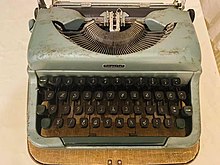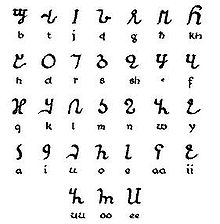| Osmanya 𐒍𐒖𐒇𐒂𐒖 𐒋𐒘𐒈𐒑𐒛𐒒𐒕𐒖 | |
|---|---|
| Script type | Alphabet |
| Published | 1920-1922 |
| Time period | c.1922 — c.1972 |
| Direction | Left-to-right |
| Languages | Somali language |
| ISO 15924 | |
| ISO 15924 | Osma (260), Osmanya |
| Unicode | |
| Unicode alias | Osmanya |
| Unicode range | U+10480–U+184AF |

The Osmanya alphabet (Farta Cismaanya, 𐒍𐒖𐒇𐒂𐒖 𐒋𐒘𐒈𐒑𐒛𐒒𐒕𐒖), also known as Far Soomaali (𐒍𐒖𐒇 𐒘𐒝𐒈𐒑𐒛𐒘, "Somali writing") and, in Arabic, as al-kitābah al-ʿuthmānīyah (الكتابة العثمانية; "Osman writing"), is an alphabetic script created to transcribe the Somali language. It was invented by Osman Yusuf Kenadid, the son of Sultan Yusuf Ali Kenadid and brother of Sultan Ali Yusuf Kenadid of the Sultanate of Hobyo.
History

While Osmanya gained reasonably wide acceptance in Somalia and quickly produced a considerable body of literature, it proved difficult to spread among the population mainly due to stiff competition from the long-established Arabic script as well as the emerging Somali Latin alphabet developed by a number of leading scholars of Somali, including Musa Haji Ismail Galal, B. W. Andrzejewski and Shire Jama Ahmed.
As nationalist sentiments grew and since the Somali language had long lost its ancient script, the adoption of a universally recognized writing script for the Somali language became an important point of discussion. After independence, little progress was made on the issue, as opinion was divided over whether the Arabic or Latin scripts should be used instead.
In October 1972, because of the Latin script's simplicity, its ability to cope with all of the sounds in the language, and the widespread existence of machines and typewriters designed for its use, President Mohamed Siad Barre required it for writing Somali instead of the Arabic or Osmanya scripts. Barre's administration subsequently launched a massive literacy campaign designed to ensure its sole adoption, which led to a sharp decline in use of Osmanya.

Description
The direction of reading and writing in Osmanya is from left to right. Letter names are based on the names of letters in Arabic, and the long vowels uu and ii are represented by the letters waaw and yaa, respectively.
Letters
| Osmanya | Name | Latin | IPA | Osmanya | Name | Latin | IPA | Osmanya | Name | Latin | IPA |
|---|---|---|---|---|---|---|---|---|---|---|---|
| 𐒀 | alef | ʼ | [ʔ] | 𐒁 | ba | b | [b] | 𐒂 | ta | t | [t] |
| 𐒃 | ja | j | [d͡ʒ] | 𐒄 | xa | x | [ħ] | 𐒅 | kha | kh | [χ] |
| 𐒆 | deel | d | [d] | 𐒇 | ra | r | [r] | 𐒈 | sa | s | [s] |
| 𐒉 | shiin | sh | [ʃ] | 𐒊 | dha | dh | [ɖ] | 𐒋 | cayn | c | [ʕ] |
| 𐒌 | ga | g | [ɡ] | 𐒍 | fa | f | [f] | 𐒎 | qaaf | q | [q] |
| 𐒏 | kaaf | k | [k] | 𐒐 | laan | l | [l] | 𐒑 | miin | m | [m] |
| 𐒒 | nuun | n | [n] | 𐒓 | waw, uu | w, uu | 𐒔 | ha | h | [h] | |
| 𐒕 | ya, ii | y, ii | 𐒖 | a | a | 𐒗 | e | e | |||
| 𐒘 | i | i | 𐒙 | o | o | 𐒚 | u | u | |||
| 𐒛 | aa | aa | 𐒜 | ee | ee | 𐒝 | oo | oo |
Numbers
| Digit | 0 | 1 | 2 | 3 | 4 | 5 | 6 | 7 | 8 | 9 |
|---|---|---|---|---|---|---|---|---|---|---|
| Osmanya | 𐒠 | 𐒡 | 𐒢 | 𐒣 | 𐒤 | 𐒥 | 𐒦 | 𐒧 | 𐒨 | 𐒩 |
Unicode
Main article: Osmanya (Unicode block)Osmanya was added to the Unicode Standard in April 2003 with the release of version 4.0.
The Unicode block for Osmanya is U+10480–U+104AF:
| Osmanya Official Unicode Consortium code chart (PDF) | ||||||||||||||||
| 0 | 1 | 2 | 3 | 4 | 5 | 6 | 7 | 8 | 9 | A | B | C | D | E | F | |
| U+1048x | 𐒀 | 𐒁 | 𐒂 | 𐒃 | 𐒄 | 𐒅 | 𐒆 | 𐒇 | 𐒈 | 𐒉 | 𐒊 | 𐒋 | 𐒌 | 𐒍 | 𐒎 | 𐒏 |
| U+1049x | 𐒐 | 𐒑 | 𐒒 | 𐒓 | 𐒔 | 𐒕 | 𐒖 | 𐒗 | 𐒘 | 𐒙 | 𐒚 | 𐒛 | 𐒜 | 𐒝 | ||
| U+104Ax | 𐒠 | 𐒡 | 𐒢 | 𐒣 | 𐒤 | 𐒥 | 𐒦 | 𐒧 | 𐒨 | 𐒩 | ||||||
Notes
| ||||||||||||||||
See also
Notes
- Dadweynaha, Somalia Wasaaradda Warfaafinta iyo Hanuuninta (1974). The Writing of the Somali Language: A Great Landmark in Our Revolutionary History. Ministry of Information and National Guidance. p. 5.
- Dadweynaha, Somalia Wasaaradda Warfaafinta iyo Hanuuninta (1974). The Writing of the Somali Language: A Great Landmark in Our Revolutionary History. Ministry of Information and National Guidance. p. 16.
- Tosco, Mauro (2015). "Djibouti: AGA" (PDF). The Intergovernmental Academy of Somali Language: 196–197.
- Abdullahi, Mohamed Diriye (2001). Culture and Customs of Somalia. Greenwood Publishing Group. p. 73. ISBN 978-0-313-31333-2.
- Lewis, I. M. (1999). A Pastoral Democracy: A Study of Pastoralism and Politics Among the Northern Somali of the Horn of Africa. James Currey Publishers. ISBN 978-0-85255-280-3.
- Ministry of Information and National Guidance, Somalia, The writing of the Somali language, (Ministry of Information and National Guidance: 1974), p.5
- Andrew Simpson, Language and National Identity in Africa, (Oxford University Press: 2008), p.288
- Economist Intelligence Unit (Great Britain), Middle East annual review, (1975), p.229
- Mohamed Diriye Abdullahi, Culture and Customs of Somalia, (Greenwood Press: 2001), p.73
References
- I.M. Lewis (1958) Bulletin of the School of Oriental and African Studies, University of London, Vol. 21 pp 134–156.
External links
- Osmanya, Borama, Wadaad's writing and the Somali language
- Afkeenna iyo fartiisa - a book in Osmanya
- Somali Native Alphabet
- The report of the Somali Language Committee
- Unicode assignments for Osmanya characters
- Osmanya Unicode Fonts
- Osmanya online keyboard - Lexilogos
- Somali Osmaniya Transliterator
| Writing systems | |
|---|---|
| Index of language articles | |
| Overview | |
| Lists |
|
| Types | |
| Current examples | |
| Related topics | |